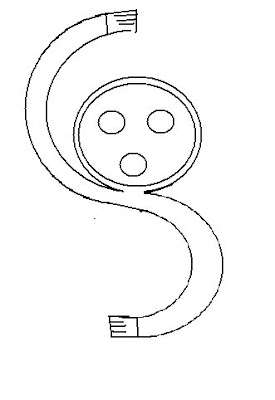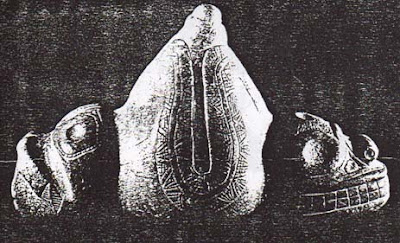Notes
La madera en el arte taino de Cuba
Created by Miguel Sague Jr Aug 22, 2024 at 2:46am. Last updated by Miguel Sague Jr May 5.
AKWESASNE NOTES history
Created by Miguel Sague Jr Jun 12, 2023 at 4:15pm. Last updated by Miguel Sague Jr Jun 12, 2023.
registration form art all night Pittsburgh
Created by Miguel Sague Jr Apr 17, 2023 at 10:58am. Last updated by Miguel Sague Jr Apr 17, 2023.
Events
The Identity of GuaBanCex, spirit of natural disasters
Takaji My Relatives
The months of June, July, August and September are typically recognized as the hurricane season in the Caribbean. I want to take a moment here now that we are actually in that period of the year to re-publish a blog I shared years ago about the Taino semies Hu-Rakan and GuaBanSex and their relationship

Fernandez Mendez also identified a female spiritual entity associated with turbulent weather and associated her with the mother-deity we now recognize as Ata Bey. This other entity is called GuaBanCex. GuaBanCex was clearly identified in the writings of the early Spanish chronicler Ramon Pane as a spirit that controlled catastrophic weather patterns and was escorted by two male companion spirits, Guatauba and Coatriskie. The first was a herald who controlled the booming explosive manifestations of thunder and lightning as if playing a mighty celestial mayowakan drum. The second was the master of torrential precipitation who had the power of gathering the waters of the earth and allow them to pour unto the land creating destructive floods.

In this sculpture the powerful deity is represented as a fierce serpent, an animal that Fernandez-Mendez clearly identified as one of the manifestations of the mother spirit. This serpent's body appears coiled about the bulbous sloping form of a kind of mountain whose shape is undeniably that of a human female breast. The way in which the serpent's body is positioned around this divine breast-mountain suggests that it is actually descending down the side and around the mountain presenting a kind of down-hill streaming motion, with its head at the bottom of the mountain and the tail coiled tightly around the top. In this image we see a perfect pictoral representation of the undulating coils of the constrictor snakes that abound on the Caribbean islands, but at the same time we see a clear representation of the downward serpentine, streaming flow of destructive all-consuming lava or pyroclastic flow punctuated at its lower extremity by the wide-open toothy maw of the female serpent as its head reaches the bottom of the mountain.
Comment
-
Comment by Michelle Inarú Ropará on January 22, 2021 at 12:31pm
-
Hahom very much for this information, brother. I have been very confused about this myself since beginning the study of my ancestors this past year and a half. This clears up some questions I had.
-
Comment by Miguel Sague Jr on May 29, 2019 at 1:38pm
-
Carter, your comment exhibits amazing insight and a thorough understanding of Maya sacred narrative tradition. The parallels you discovered between the manifestations of the Guabancex triad and the HunRakan triad are right on point and were actually pointed by several scholars who have made serious in-depth comparative studies of both cultures. There is absolutely no doubt that ancient Taino culture and ancient Maya culture experienced repeated and possibly sustained contact and interaction with each other. The research of scholars such as the archeologist Pendergast from Canada who carried out work in both the Maya site of Altun Ha in Central America and also the Taino site of Los Buchillones in Cuba proves that the connections indeed existed. The researcher Sebastian Robiou Lamarche makes references to the similarity in the names of the whirling, one-legged Maya deity of the hurricane and of the spinning Big Dipper-Little Dipper constellation complex ( Heart of Heaven) and the spinning whirlwind entity of Taino spirituality called Hurakan. I love meeting people who are acquainted with the Popol Vuh. Have you done any study of the work of Dennis Tedlock and Linda Schele?
-
Comment by Carter on May 28, 2019 at 11:22pm
-
Hey Miguel! Really liked the blog found it very informative I just wanted to know if you were just using Hu-Rakan in context of just the Taino semies and not the mayan deity himself which I've been reading alot on and in the mayan Popol Vuh which he is described as more than just a spirit of the whirlwind in fact from what I've read there is connections to the earth for it was him who invoked the earth to rise up from the depths of the endless sea and form land he's also associated with the flood that ravaged the earth. Not only that, but he was one of the main creators associated with fire as well and in some text natural disasters same as Guabancex. What really caught my eye was the kinda trinity system set in place with Guatauba and Coatriskie which is very similar to The Heart of Heaven trinity with Chipi Culha, Raxa Caculha, and Huracan which can be found in the Popol Vuh and if we were comparing the Mayan Huracan counterpart there would be alot of connections but I also understand the dual aspect of Guabancex and Ata Bey however it's not uncommon for deities to be both masculine and feminine if you were to propose the idea of the two being similar.
-
Comment by luis jabier on March 15, 2018 at 12:10pm
-
I'm sorry for not having responded. I thought I had given you an answer. about the comment. but thank you for the information I will begin to read immediately
-
Comment by Miguel Sague Jr on February 25, 2018 at 9:45am
-
Takahi my relative Luis
The fact is that although we have no specific mention from the early Spanish chroniclers of a "dragon" per se in Taino culture, we can actually go to the culture of the near-by neighboring Indigenous nations, the Mayas and other Meso American peoples, and we find a lot of indications of belief in dragon-like creatures in their mythology. We also find references to dragons within Maya tradition in the book THE FACE OF THE ANCIENT AMERICAS by Wally and Brenda Zollman We also find mentions of sacred dragon entities in the writings of the American researcher Linda Schele especially in her book "Maya Cosmos". The fantasy website Auroswords.com makes reference to dragons and dragon-like creatures in Mexican and Central American mythology. We in the Caney Circle recognize that our ancient Taino ancestors maintained a cultural relationship with those Mexican and MesoAmerican cultures across the Caribbean. There was a lively trade in beliefs and traditions between the island people and the Central American mainland people. We understand that much of this culture (including beliefs in sacred dragons) was adopted by Taino people and incorporated into their own mythology. We believe that the ancient Taino associated Guabancex with the concept of a fearsome celestial dragon-like serpent and that also there was a belief in a dragon-like crocodile creature that represented the surface of the earth.
-
Comment by luis jabier on February 21, 2018 at 11:01pm
-
Hi, how are you, Miguel? I was wondering if you have more information of guabancex.
So I've been wondering if there is a dragon in the Caribbean. since everyone has a dragon in ther continent.So I decided to look for what I would classify as dragon. this is what I found in 4 dictionaries.
Webster's Dictionary: drag.on \'drag-en\ n dracon-,draco serpent,dragon, [fr.GK drakon;akin to OE torht bright,Gk derkesthai to see,look at] 1 archaic: a huge serpent
2:a fabulous animal usually represented as a monstrous winged and scaly serpent or saurian with a crested head and enormous claws.
Tormont Illustrated Encyclopedia: drag'en n. 1. a. A fabulous monster, represented usually as a gigantic reptile breathing fire and having a lion's claws, the tail of a serpent, wings and scaly skin.
b. A figure or other representation of this creature. 2. Archaic. A large snake or serpent [Middle English drago(u)n, from Old French dragon, from Latin draco (stem dracon-), dragon, serpent, from Greek drakon, serpent.
in the dictionaries that I find I found that a dragon is a huge serpent. J. R. R. Tolkien refers to his dragons as a serpent of fire.
Eastern Dragon The dragons are said to be made up of many different types of animals of the Earth: the body of a snake, scales of a carp (fish), head of a camel, horns of a giant stag (deer), the eyes of a hare (rabbit), ears like a bull, a neck like an snake, belly of a clam, paws like a tigers, and claws like an eagle. Most of the time they are shown to have a lion-type mane
Guabancex she is a snake, controls fire and air 3 features in a dragon. she is a force of nature like the dragons of the east .
I know this is not conclusive information. so I ask you if you have more in formation of this lady
-
Comment by Miguel Sague Jr on July 31, 2014 at 8:04am
-
My brother Frank that is a very reasonable request and I will try to maketimeto provide my behikes in training with more of the sacred imagery in the form of posters and clay forms that you need for ceremony
-
Comment by Jeffry Mucaro Blake Johnson on July 29, 2014 at 7:59am
-
Wonderful! Bo'matun, Miguel!
-
Comment by Miguel Sague Jr on July 28, 2014 at 3:04pm
-
Marohu LINK
-
Comment by Miguel Sague Jr on July 28, 2014 at 2:57pm
-
Marohu's tears are said to be the rain drops
© 2025 Created by Network Financial Administration.
Powered by
![]()
You need to be a member of Indigenous Caribbean Network to add comments!
Join Indigenous Caribbean Network